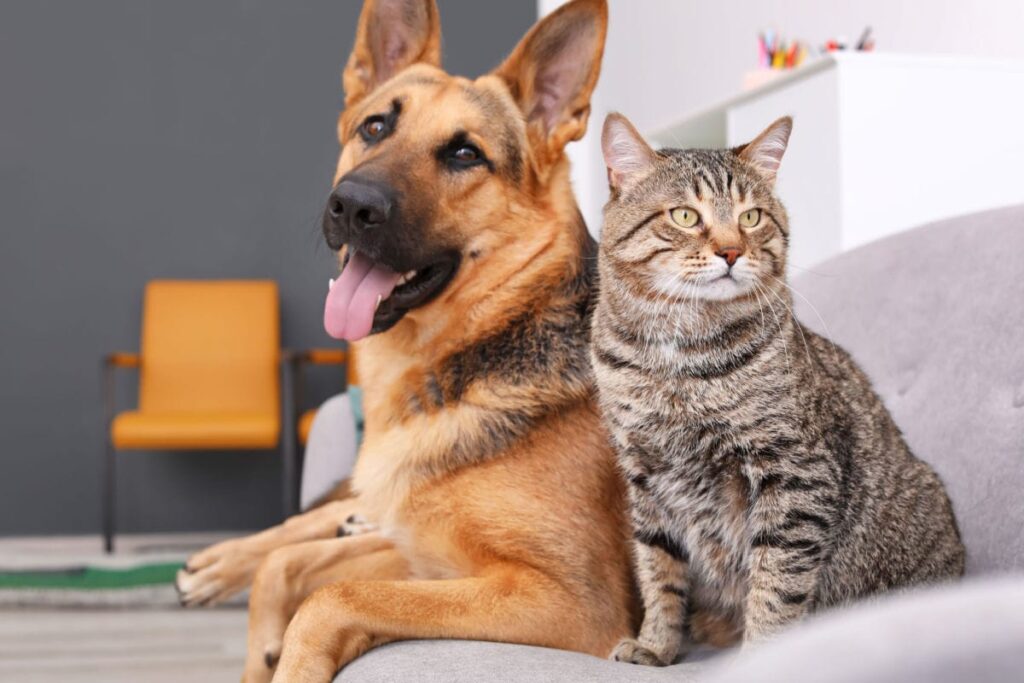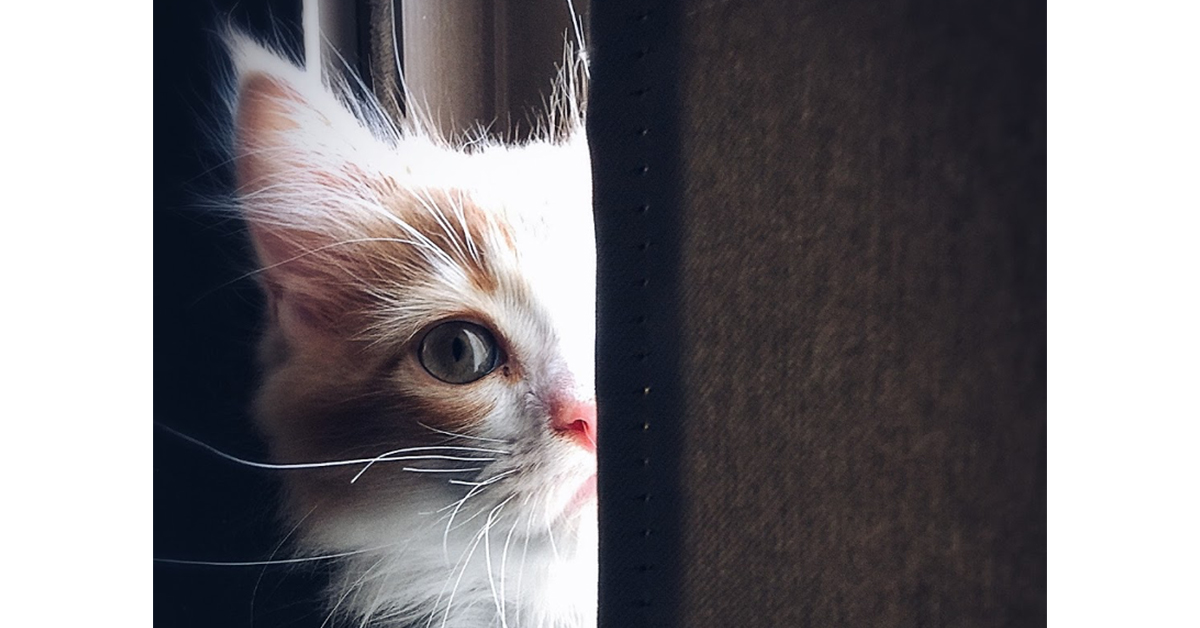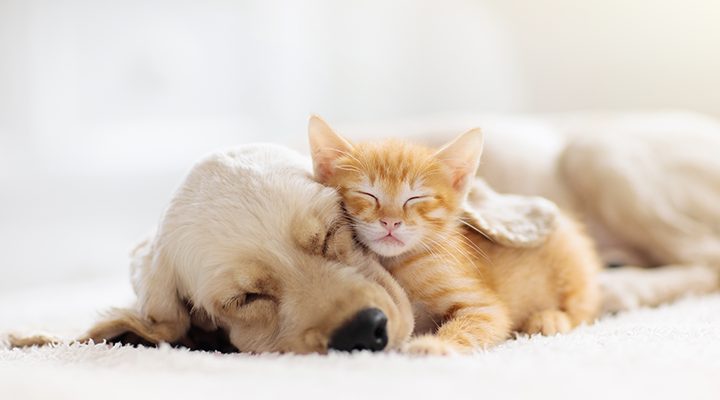Introducing New Dog to Cats
We’ve all seen those sweet pictures of dogs and cats cuddling together. The golden retriever spooning a new kitten, the kitten tugging at the Rottie’s face. It’s a little like a Disney movie coming to life.
With the internet flooded with such cuteness, it’s natural to think you can get a new dog or new cat and they’ll be instant best friends. Just add awww…. But the reality is often different.
You might find your senior cats want nothing to do with the new pup you’ve brought home. They might even show aggression toward the new four-legged family member when they come face-to-face for the first time.
You don’t want a battle of the species on your hands.
How does a pet parent introduce a new dog to your cat(s) and have it go well? They don’t have to be instant friends, but you do want to manage safety and keep the stress levels low.
It starts with your expectations.
How to Introduce a New Dog to Cats

When you’re dealing with personalities, every situation is different. When introducing a new dog to cats, maybe they become fast friends. But a senior pet may not be thrilled with a new addition to the household. The key is knowing the animal’s personalities.
What’s your resident cat like? How old is your kitty? What about the doggo? Do they have experience with the other species?
After all, cats can be territorial. You don’t want to bring home a friendly puppy bounding with energy who’s going to get all the attention and see your aloof, senior cat as a playmate. That can result in hurt feelings (on the doggo’s side) and maybe even a scraped nose. You’ll also have a miffed feline on your hands.
Here’s how you can coordinate an introduction process that starts things off on the right foot…er…paw.
Questions to Consider
You’ll want to consider the personalities of the cats and dogs in question before their first introduction.
- How old are they?
- Are they easy-going? Timid? Grumpy? Aggressive?
- What’s their cat experience/history?
If you’re considering adopting a dog and you already have cats, you’ll want to ask how the dog is with cats. Some are fine. Some will ignore the cat. Others will want to be playmates, others will want to chase your cat and make its life miserable.
Obviously, you don’t want the latter. Some dogs have a high prey drive and may see your cat as prey. Dog breeds like terriers and greyhounds fall into this category. This is instinct so don’t try to go against it.
If you adopt a dog from the Humane Society, they’ll usually have an idea of a dog’s personality and whether or not he’ll be good around cats.
But let’s say the pup’s cat experience checks out and it’s not going to make a game of chasing your cat.
Then what?
You’ll want to slowly introduce your new pets to one another. In fact, you’ll want to carefully plan your introduction and those first few days at home together while keeping an eye on the body language. Also, let your resident cat(s) take the lead. They were there first after all and they can be territorial.
It’s a good idea to make sure your cat has an escape route. Even a cat tree could be sufficient if the dog is small and the cat can easily escape up the scratching post.
Body language, like the new dog lunging at the cat, is a sign that you’ll need to back things up. But other signals can be more subtle.
You’ll also want to make a plan for where the new dog will be in relation to your cat’s food and litter box. After all, an animal behaviorist would recommend keeping these important items out of the dog’s reach.
Let Them Smell One Another Before the First Introduction

You already know dogs are sensitive to smells, and vice versa. You can use this to your advantage to help them get used to one another using pheromones without the potential added drama of live interaction.
To do this, you can take a towel or a t-shirt, leave it in one animal’s favorite sleeping place for a few days, then swap them. That way, each animal gets the chance to smell the other before they even meet them. That will help them seem more familiar.
Then, try putting the fabric near the food dish. Now you have the scents connected to eating which is positive reinforcement.
Ideally, you can do this before you bring the dog home. When you do bring the dog home, you’ll want to keep the dog and cat separated for the first few days and supervise their first meetings.
Prepare for the Meet & Greet

The first few days set the stage for your new pet’s relationship with one another so that first meeting is critical.
When introducing a new dog to cats, pet experts recommend taking turns confining the animals so the other animal can explore. For example, you might confine your resident cats in a familiar room with their litter tray, food, and water.
Include their favorite toys and bed if they have a favorite. Keep that fabric that smells like the pup in there.
Meanwhile, the new dog can have free range to explore (with your supervision of course). Depending on the individual dog, you may choose to restrict them to the kitchen or a laundry room for the first few days as they get accustomed to the new environment.
Depending on how the animals are behaving, you can let the cats out to explore after a few hours or a couple of days. You might have the pup crated in a separate room. This gives you the chance to evaluate their behavior in this new situation.
If everything seems to be going ok, after a day or two, you can up the ante. For example, you can let everyone out but keep them in separate rooms with a baby gate in between. This lets them sniff one another with a barrier in place. You can use the positive reinforcement training method by praising and feeding treats to both your dog and cat during this phase.
If everyone seems OK, then you can ease the barrier away. Keep up the praise and treats to encourage positive associations. (Training treats are great for such times.)
However, if the dog seems obsessed with the cat and your kitty is puffed like a Halloween decoration, then you’ll need to step back. Aggressive behavior can show up as lunging or growling. On the other hand, sometimes play is mistaken as aggressive when it’s not meant to be. For example, a dog who’s doing a play bow and barking happily might be misunderstood by you and your cat.
It’s a good idea to make sure your cats have an escape route to their favorite hiding places during these supervised meetings. That way, the kitties can run and hide in a safe space if your cat feels nervous.
During this transition time, you don’t want to leave them unattended and loose. If your pets will be home alone, make sure everyone is safely separated in their own space. You can leave a dog crated and in a safe place with a closed door where the resident cats can’t come in, for example.
Introducing Cats to Dogs: Summary

As you can see, it takes a bit of planning, calm behavior, and patience when it comes to introducing a new dog to cats.
You’ll want to consider the personalities of the new dog and cat. Try to find out their experience with other dogs and cats as that can be an indicator. Some dogs have a prey instinct and will be aggressive with cats. That’s not something that’s likely to change so such a dog won’t be a good companion for your kitty.
But if the dog is friendly, then introducing them to your cat can be done safely and in a way to minimize stress. They’ll be furry friends in no time.
Have you ever had to introduce a new pet to an existing pet? What kind of techniques did you use? Share in the comments!

